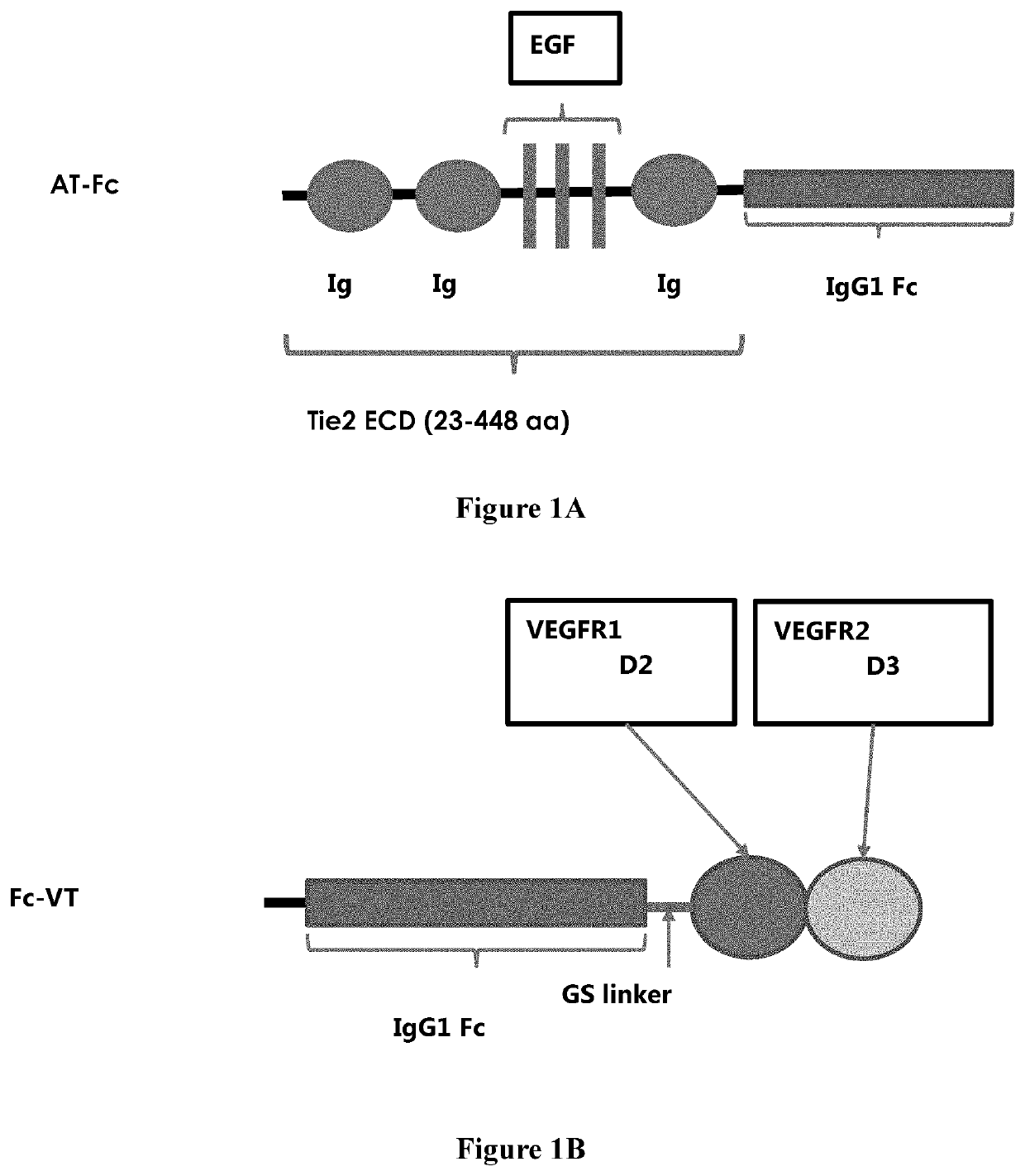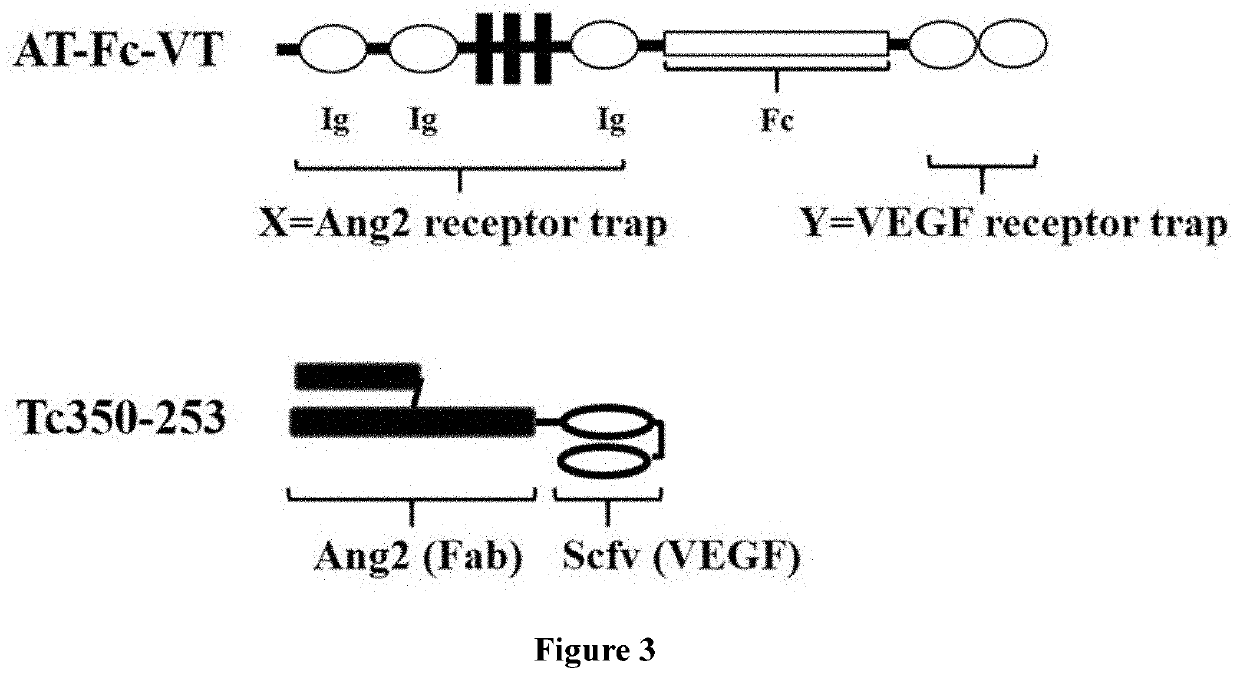Anti-angiogenesis fusion protein and uses thereof
- Summary
- Abstract
- Description
- Claims
- Application Information
AI Technical Summary
Benefits of technology
Problems solved by technology
Method used
Image
Examples
example 1
Expression and Purification of Angiogenesis Blockers
[0071]The TIE2 ECD amino acid residues from 23-448 was used as ANG binding motif, and the chimeric domains with VEGFR1 D2 and VEGFR2 D3 were used as VEGF binding trap. The corresponding DNAs were synthesized and fused with IgG1 Fc fragment gene at C-terminal for ANG blocker (AT-Fc) (FIG. 1A) or at N-terminal for VEGF blocker (Fc-VT) (FIG. 1B) with a short flexible GS linker was placed in between. To construct bi-functional AT-Fc-VT expression vector, AT-Fc was fused with GS linker and the VEGF motif, sequentially, at C-terminal (FIG. 3). These fusion constructs were cloned to pCI-neo (Promega, Inc.) expression vector between the EcoR I and Not I restriction sites under the control of a CMV promoter. The vector contains a Neomycin resistant gene and an Ampicillin resistant gene for mammalian cell selection and E. coli propagation. All fusion constructs contained a signal peptide at the N-terminal for the secretion of soluble fusion ...
example 2
In Vitro Binding of Angiogenesis Blockers
[0074]Overnight ligand pre-coated (100 ng / well) wells were washed 3 times with 1× PBS and blocked with 400 ul 5% non-fat skin milk in PBS for 2 hr. After blocking, 100 ul of 3-fold serially diluted purified protein started from 30 nM were added to each corresponding well in duplicate and incubated for 1 hr at room temperature on shaker. After binding, wells were washed 3 times with PBST (1× PBS with 0.1% Tween-20) before adding 100 ul of 1:2500 diluted goat anti-human IgG Fe HRP conjugates (Jackson ImmunoResearch Inc.) to each well and incubated on shaker for another hour. After final washing, TMB reagent (Invitrogen, Inc.) was added and OD absorption at 450 nm was measured. The data analyzed by sigmoidal curve fitting using Prism 4. Binding of AT-Fc, Fc-VT, and AT-Fc-VT to ANG or VEGF were assessed by similar assays.
[0075]As shown in FIG. 6, the calculated EC50 for AT-Fc against ANG1 and ANG2 are 4.26 nM and 2.01 nM, respectively. The result...
example 3
Inhibition of VEGF-Dependent HUVEC Proliferation Assay by Angiogenesis Blockers
[0079]The Fc-VT and AT-Fc-VT were used to inhibit VEGF activities in a cell base assay. Human Umbilical Vein Endothelial Cells (HUVEC cells, Lonza, Inc.) were used to demonstrate VEGF-dependent cell proliferation which can be inhibited by VEGF blocker. In the experiment, HUVECs were maintained in the Endothelial Cell Growth Medium (Lonza, Inc.) with 2% FBS. Collagen pre-coated wells were loaded with 50 ml of 1 nM of VEGF-A (R&D systems, Inc.) and various concentrations of Fc-VT or AT-Fc-VT per well for 1 hour at 37° C. before adding 50 ml of HUVECs at 1×105 cells / ml in Medium-199 (10% FBS, Hyclone, Inc.) to each well. After 72 hours incubation at 37C with 5% CO2, the cell growth was assayed by adding 10 ml MTS detection reagent (Promega Inc.) to each well and then measuring OD absorption at 450 / 650 nm.
[0080]As shown in FIG. 10, the 50 percent inhibitory activity (IC50) of AT-Fc-VT on VEGF-dependent HUVEC ...
PUM
| Property | Measurement | Unit |
|---|---|---|
| Flexibility | aaaaa | aaaaa |
Abstract
Description
Claims
Application Information
 Login to View More
Login to View More - R&D
- Intellectual Property
- Life Sciences
- Materials
- Tech Scout
- Unparalleled Data Quality
- Higher Quality Content
- 60% Fewer Hallucinations
Browse by: Latest US Patents, China's latest patents, Technical Efficacy Thesaurus, Application Domain, Technology Topic, Popular Technical Reports.
© 2025 PatSnap. All rights reserved.Legal|Privacy policy|Modern Slavery Act Transparency Statement|Sitemap|About US| Contact US: help@patsnap.com



